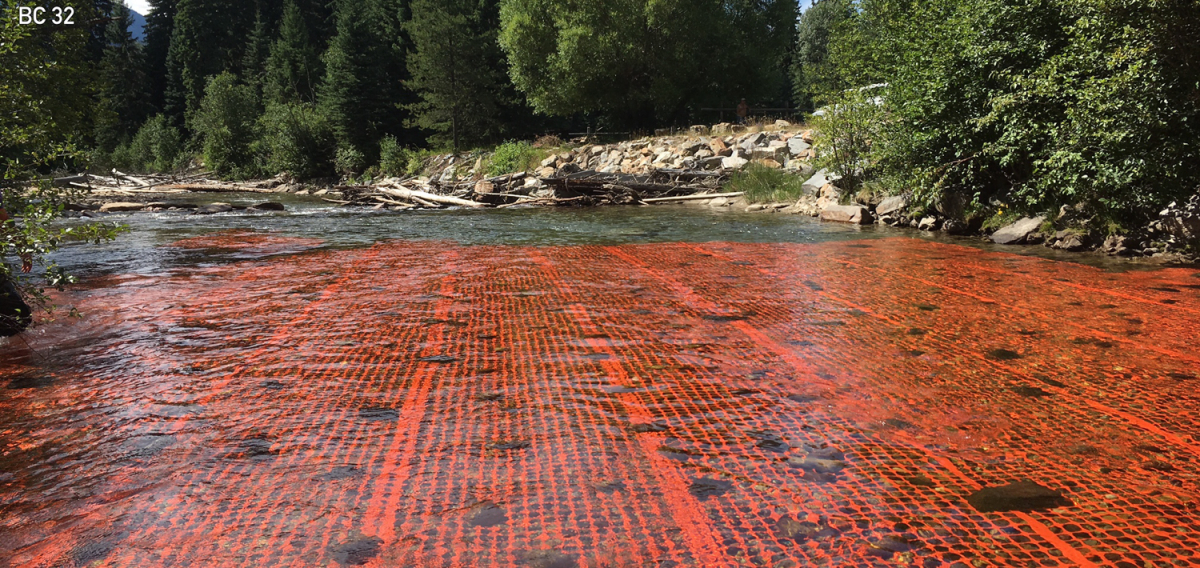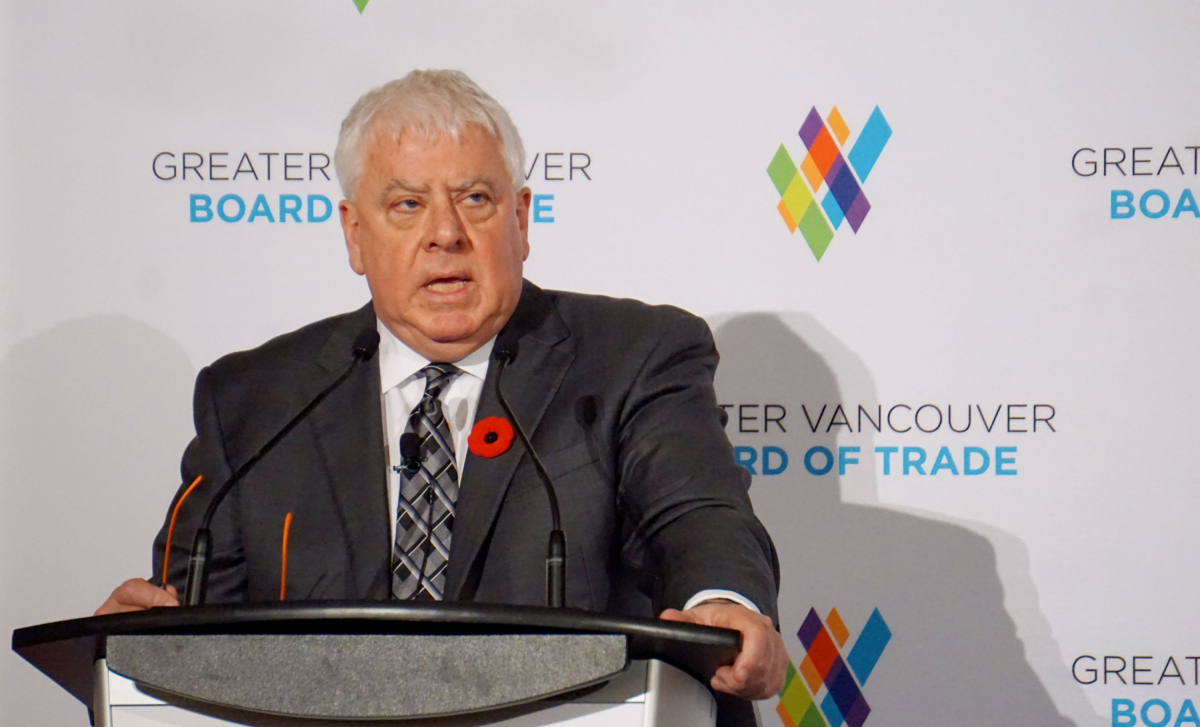Support strong Canadian climate journalism for 2025
A Texas-based multinational energy company dodged questions on Thursday about whether it inaccurately reported the number of streams on the route of its major Canadian west coast pipeline project.
Instead, it warned its federal regulator, the National Energy Board (NEB), that its project, the Trans Mountain expansion, was facing significant delays because of federal orders requiring it to stop construction activity. Those orders, the company said, could allow fish to spawn in areas that would delay the pipeline's anticipated in-service date, expected to be in late 2019.
Both issues were triggered by a blog posted on Sept. 12 by Kinder Morgan about how it was deploying special mats on some streams to deter fish such as salmon and trout from spawning in streams where they could be killed during construction of the pipeline.

Once completed, Trans Mountain would expand an existing line linking Alberta's oilsands producers to a terminal and port in Burnaby on the west coast of British Columbia. The expansion would triple the line's capacity to about 890,000 barrels of oil per day.
But the company is legally required to provide an inventory of water crossings before proceeding with construction.
The blog provided new information about the number of streams identified on the Trans Mountain route. Although the company had identified 25 different streams in a submission filed with the regulator on June 22, it later identified 26 streams in the Sept. 12 blog.
Ten days later, the NEB told Kinder Morgan's president Ian Anderson in a Sept. 22 letter that the company appeared to be breaking the law and that none of the work to deploy anti-spawning mats should have begun in the absence of "numerous" approvals.

Kinder Morgan lawyer asked for "relief"
On Thursday, a Calgary-based lawyer representing Kinder Morgan sent the NEB a letter asking whether the regulator could provide some "relief" from the law. The lawyer — Shawn Denstedt, from the firm of Osler, Hoskin and Harcourt —noted in the Sept. 28 letter that this is what the regulator has done in the past, including last May, when it made an exception to one of the 157 mandatory conditions imposed when Prime Minister Justin Trudeau announced his government had approved the Kinder Morgan project in November 2016.
That previous exception, explained in a letter sent by the NEB to Denstedt on May 19, gave Kinder Morgan more time to provide the regulator with details about the design of electrical systems at its pump stations and terminals.
This time, Kinder Morgan's lawyer explained that there was more on the line if the board failed to "expedite" a request to let the company install deterrents to keep fish away from "key watercourses" with "high spawning potential."
Denstedt wrote that if the regulator waited too long, the fish might enter streams on the pipeline route and trigger other rules that would prevent construction from proceeding, the letter said.
"Deterrent installations may (as a result) be delayed for a year (i.e., in 2018), which would delay construction of the corresponding crossing for a full year, potentially impacting the Project in-service date," wrote Denstadt, in the letter to the NEB.
The delays faced by Kinder Morgan represent the second potential setback for a Canadian oilpatch expansion project over the past few weeks, triggered by federal efforts to impose and enforce rules. On Sept. 7, TransCanada Corp. announced it wanted to suspend its application for the Energy East pipeline due to stringent rules requiring an evaluation of the project's cumulative impacts on climate change.
Oil producers and the Canadian business community say that projects like the Trans Mountain Expansion and Energy East are needed to support jobs and growth in Canada's slumping oilpatch. Opponents say new pipelines will lead to spills and push Canada's climate change goals out of reach.
Denstedt's letter was filed with the NEB after Kinder Morgan declined to answer questions from National Observer about the apparent discrepancies between what it reported to the regulator and what it told the public in its blog about the water crossings on the path of its pipeline.
'What else is going on that isn't being blogged about?'
The confusion has prompted one environmental lawyer to question whether the federal energy regulator has enough boots on the ground to adequately protect the environment and monitor the company's operations as it prepares to build the Trans Mountain expansion.
Even the regulator wasn't certain if there were 25 or 26 streams that could be affected by construction.
"It is our understanding that the company may be looking at a number less than that now, based on suitability," NEB spokesman James Stevenson told National Observer. "But again, that would be a question best posed to the company. And all of this work is currently on hold."
Stevenson also said that Kinder Morgan sent some new numbers to the NEB about the number of streams where it actually deployed anti-spawning deterrents. While the blog said that the company had deployed mats in five streams as of mid-August, Kinder Morgan told the regulator that there were now eight.
The NEB said it received this update after it sent the company its Sept. 22 warning letter.
"Trans Mountain has advised that it has installed deterrents in a total of eight salmon and trout bearing watercourses, seven located in the Valemount/Blue River B.C. area and one located in the Hinton, (Alberta) area," Stevenson said. "Trans Mountain confirms that all field activity associated with the installation of the five remaining deterrents scheduled for fall 2017 has ceased."
A lawyer with a B.C.-based environmental law firm that has been opposing the pipeline expansion project said the apparent confusion over the numbers raises "serious questions" about the federal government's capacity to monitor and ensure compliance with its own rules.
"The fact that the NEB found out this information from a blog as opposed to actually having boots on the ground is concerning," said Anna Johnston, a staff counsel with West Coast Environmental Law. "What else is going on that isn't being blogged about that we're not finding out?"
Stevenson said that the NEB has sufficient resources to fulfill its regulatory mandate and that it would "continue to apply rigorous scrutiny existing and new NEB pipelines."
The NEB spokesman also shared statistics from 2016 showing that the regulator had issued 219 enforcement actions against regulated companies, along with nine safety advisories and safety orders.
A Kinder Morgan spokeswoman, Ali Hounsell, told The Canadian Press earlier this week that the spawning deterrents were considered a "preventative measure" to minimize environmental impacts of construction. The company was expecting to begin construction of the pipeline itself in 2018.
with files from The Canadian Press
Editor's note: This article was updated at 11 p.m. PT on Thursday with new information and background, including details from a letter filed late in the day by a lawyer representing Kinder Morgan.






Comments
Corporations like Kinder Morgan buy their way out of government regulations all over the world. They expected to do so this time as well. Perhaps they will. Creating pressure, and now somehow blaming the NEB for their own failures to follow the rules is just one of the ways they operate. The NEB should hold their ground, and hang these guys on their own hubris. It is the only way any corporation will in fact cooperate. Otherwise, their ONLY interest (and quite legitimately so) is their bottom line and value to shareholders. We should expect nothing less from them, and also nothing less from the NEB.
Excuse my ignorance, but if these orange plastic mats keep spawning fish away....how does that benefit the fish? It is my understanding, naive perhaps, that spawning salmon return 'home' to lay they eggs and die near the place of their birth.
If prevented from doing so, is that spawn not simply lost? And who wants to dig into the deeper question of long term loss to the salmon, and therefore to all of us, if these pipelines get laid down across these streams? How does Kindermorgan, or any of our big project pipeline companies, put pipelines across fish bearing streams?
And speaking of boots on the ground, couldn't drones just routinely survey the route? We all know what that route is surely....or do we?
Though I suppose if an industry captured regulator just eases the rules whenever Big Oil asks them to, then all my questions are academic.
Another get out of jail free card for KM, courtesy of the NEB.